Peugeot 508 RXH 2013 Owner's Manual
Manufacturer: PEUGEOT, Model Year: 2013, Model line: 508 RXH, Model: Peugeot 508 RXH 2013Pages: 308, PDF Size: 8.95 MB
Page 161 of 308
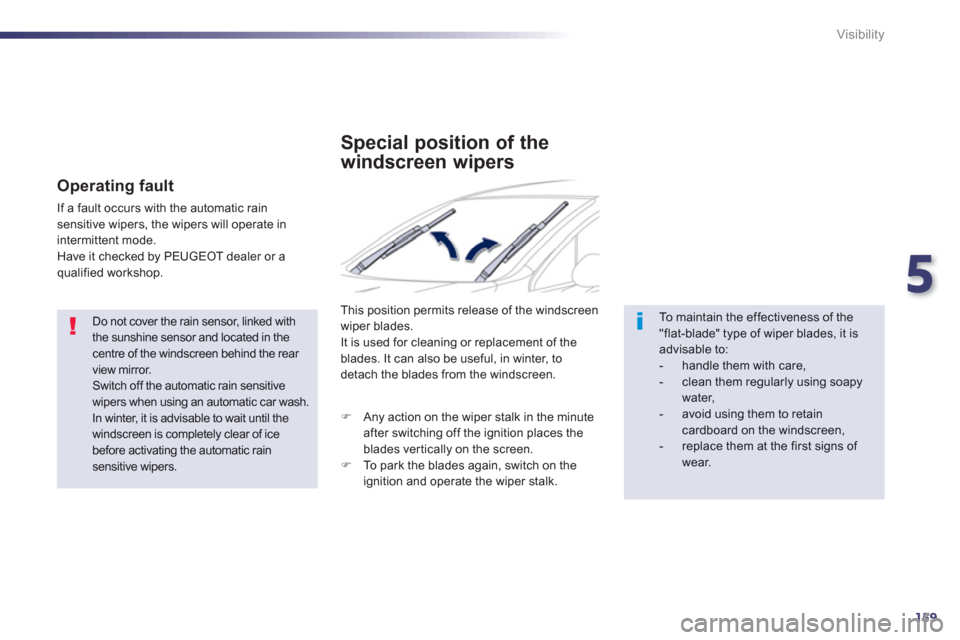
5
159
Visibility
Do not cover the rain sensor, linked with the sunshine sensor and located in the centre of the windscreen behind the rear view mirror. Switch off the automatic rain sensitivewipers when using an automatic car wash.
In winter, it is advisable to wait until the windscreen is completely clear of ice before activating the automatic rainsensitive wipers.
Operating fault
If a fault occurs with the automatic rain
sensitive wipers, the wipers will operate in intermittent mode.
Have it checked by PEUGEOT dealer or a qualified workshop.
Special position of the
w
indscreen wipers
This position permits release of the windscreenwiper blades.
It is used for cleaning or replacement of the
blades. It can also be useful, in winter, to detach the blades from the windscreen.
To maintain the effectiveness of the"flat-blade" type of wiper blades, it isadvisable to:
- handle them with care,
- clean them regularly using soapywater,
- avoid using them to retain cardboard on the windscreen,
- replace them at the first signs of wear.
�)
Any action on the wiper stalk in the minute
after switching off the ignition places the blades ver tically on the screen.�) To park the blades again, switch on theignition and operate the wiper stalk.
Page 162 of 308
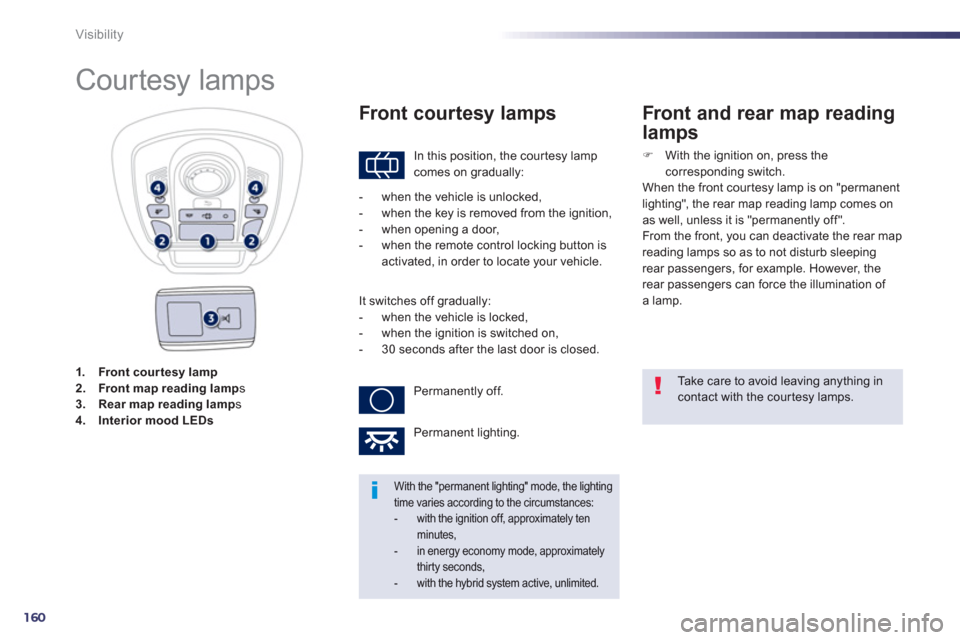
160
Visibility
1.Front cour tesy lamp2.Front map reading lamps3.Rear map reading lamp s 4.Interior mood LEDs
Courtesy lamps
In this position, the cour tesy lamp comes on gradually:
Front courtesy lamps
Take care to avoid leaving anything incontact with the cour tesy lamps.
With the "permanent lighting" mode, the lighting time varies according to the circumstances:- with the ignition off, approximately tenminutes, - in energy economy mode, approximately thirty seconds,- with the hybrid system active, unlimited.
- when the vehicle is unlocked,
- when the key is removed from the ignition,
- when opening a door,
- when the remote control locking button is
activated, in order to locate your vehicle.
It switches off
gradually:
- when the vehicle is locked,
- when the ignition is switched on,
- 30 seconds after the last door is closed.
Permanentl
y off.
Permanent lighting.
Front and rear map reading
lamps
�)With the ignition on, press the
corresponding switch.
When the front courtesy lamp is on "permanent
lighting", the rear map reading lamp comes on
as well, unless it is "permanentl
y off".
From the front, you can deactivate the rear map
reading lamps so as to not disturb sleeping
rear passengers, for example. However, the
rear passengers can force the illumination of
a lamp.
Page 163 of 308
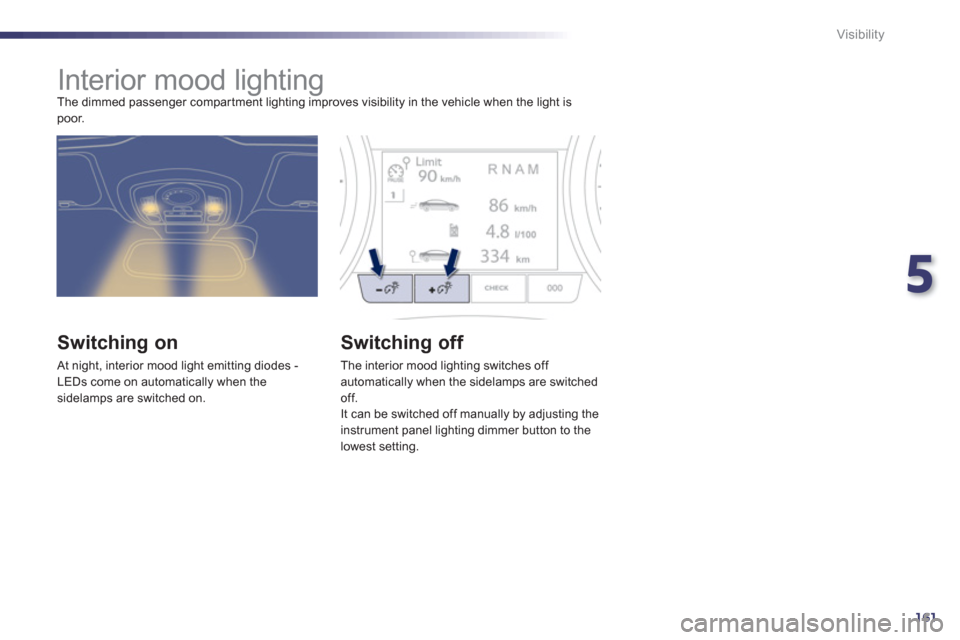
5
161
Visibility
Interior mood lighting
The dimmed passenger compar tment lighting improves visibility in the vehicle when the light is poor.
Switching on
At night, interior mood light emitting diodes -
LEDs come on automatically when the sidelamps are switched on.
Switching off
The interior mood lighting switches off automatically when the sidelamps are switched off.
It can be switched off manually by adjusting the instrument panel lighting dimmer button to the lowest setting.
Page 164 of 308
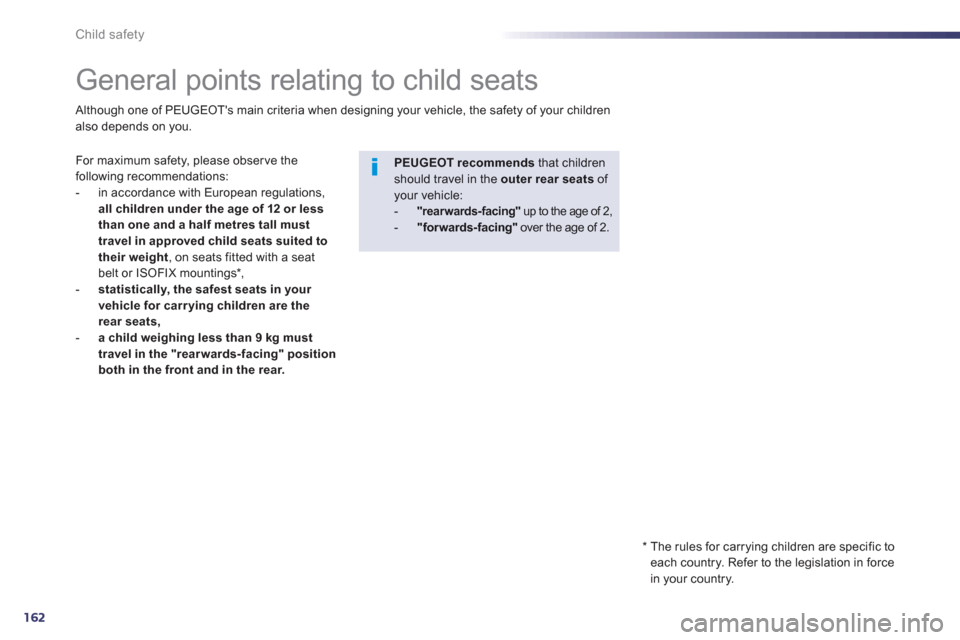
162
Child safety
General points relating to child seats
For maximum safety, please obser ve the following recommendations:
- in accordance with European regulations,
all children under the age of 12 or less
than one and a half metres tall must
travel in a
pproved child seats suited to
their weight , on seats fitted with a seat
belt or ISOFIX mountings * ,-statistically, the safest seats in your
vehicle for carrying children are the rear seats,- a child weighing less than 9 kg must
travel in the "rearwards-facing" position both in the front and in the rear.
PEUGEOT recommendsthat children should travel in the outerrear seatsof your vehicle:-"rearwards-facing"up to the age of 2, - "forwards-facing"over the age of 2.
Although one of PEUGEOT's main criteria when designing your vehicle, the safety of your childrenalso depends on you.
*
The rules for carrying children are specific to each country. Refer to the legislation in force
in your country.
Page 165 of 308
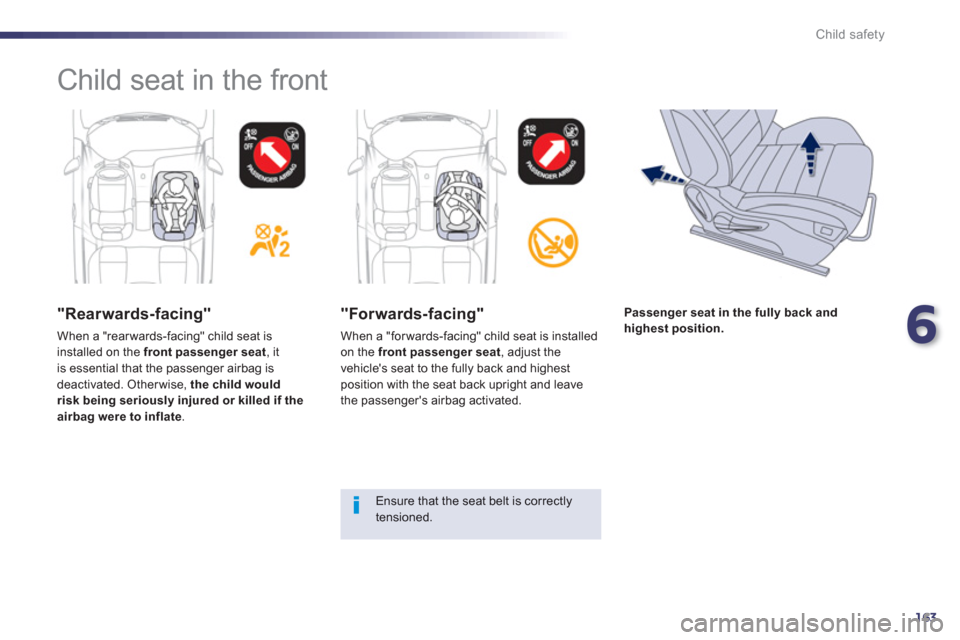
6
163
Child safety
Child seat in the front
"Rearwards-facing"
When a "rear wards-facing" child seat is installed on the front passenger seat
, itis essential that the passenger airbag is
deactivated. Otherwise, the child wouldrisk being seriously injured or killed if the airbag were to inflate .
"Forwards-facing"
When a "for wards-facing" child seat is installedon the front passenger seat, adjust the
vehicle's seat to the fully back and highest position with the seat back upright and leave
the passenger's airbag activated.
Passenger seat in the fully back and
highest position.
Ensure that the seat belt is correctly tensioned.
Page 166 of 308
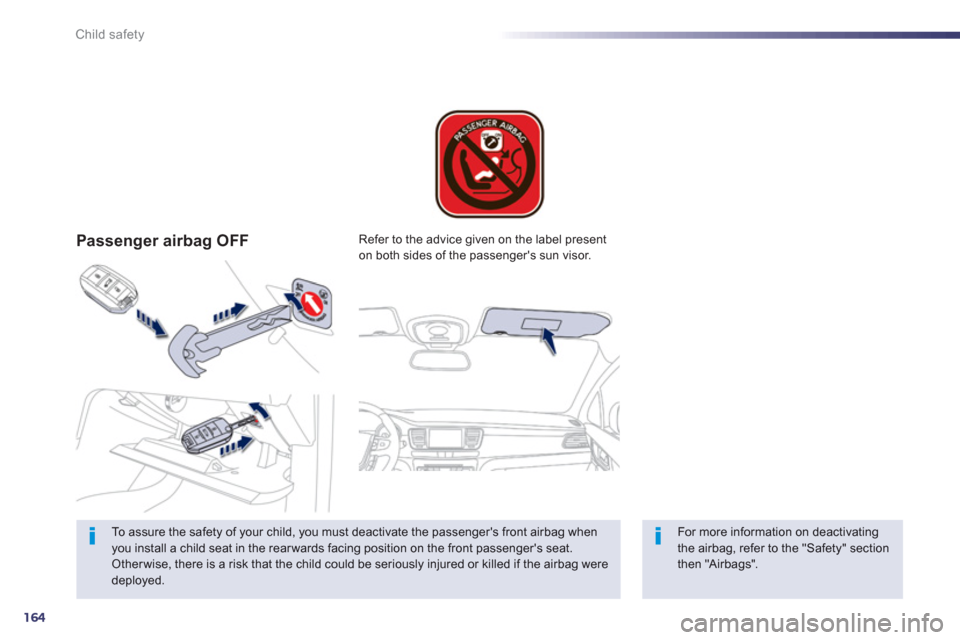
164
Child safety
Passenger airbag OFF
To assure the safety of your child, you must deactivate the passenger's front airbag when
you install a child seat in the rear wards facing position on the front passenger's seat. Other wise, there is a risk that the child could be seriously injured or killed if the airbag weredeployed.
Re
fer to the advice given on the label present
on both sides of the passenger's sun visor.
For more information on deactivating
the airbag, refer to the "Safety" sectionthen "Airbags".
Page 167 of 308
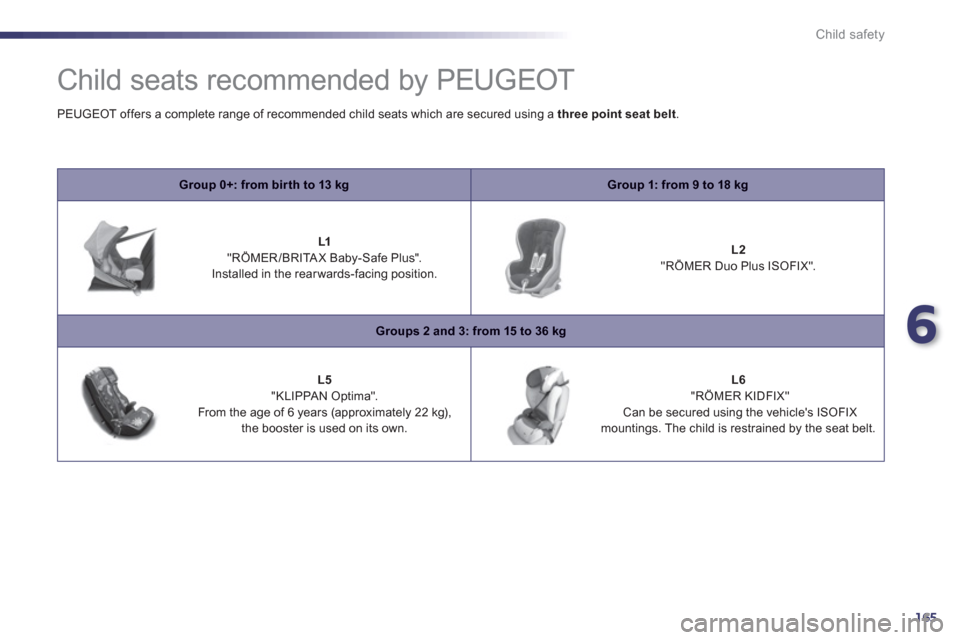
6
165
Child safety
Child seats recommended by PEUGEOT
Group 0+: from bir th to 13 kgGroup 1: from 9 to 18 kg
L1"RÖMER/BRITAX Baby-Safe Plus".
Installed in the rear wards-facing position.
L2"RÖMER Duo Plus ISOFIX".
Groups 2 and 3: from 15 to 36 kg
L5"KLIPPAN Optima".From the age of 6 years (approximately 22 kg),
the booster is used on its own.
L6 "RÖMER KIDFIX"
Can be secured using the vehicle's ISOFIX
mountings. The child is restrained by the seat belt. PEU
GEOT offers a complete range of recommended child seats which are secured using a three point seat belt.
Page 168 of 308
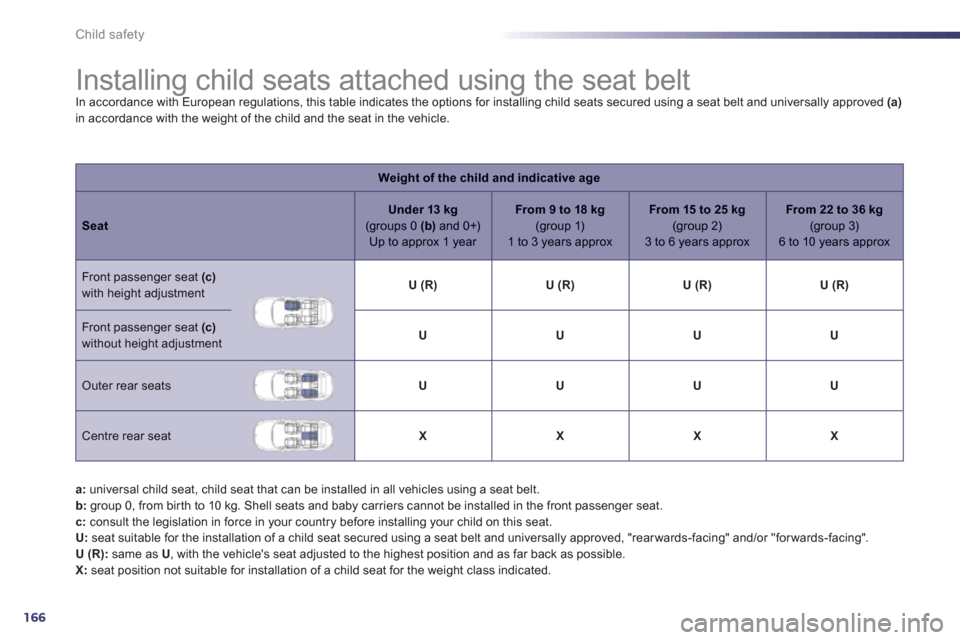
166
Child safety
Installing child seats attached using the seat belt In accordance with European regulations, this table indicates the options for installing child seats secured using a seat belt and universally approved (a)in accordance with the weight of the child and the seat in the vehicle.
Weight of the child and indicative age
SeatUnder 13 kg
(groups 0(
b )and 0+)
Up to approx 1 year
From 9 to 18 kg(group 1)1 to 3 years approx
From 15 to 25 kg
(group 2)3 to 6 years approx
From 22 to 36 kg(group 3)
6 to 10 years approx
Front passenger seat (
c )with height adjustment U (R)U (R)U (R)U (R)
Front passenger seat (c)without height adjustmentUUUU
Outer rear seatsUUUU
Centre rear seat XXXX
a:
universal child seat, child seat that can be installed in all vehicles using a seat belt. b:
group 0, from bir th to 10 kg. Shell seats and baby carriers cannot be installed in the front passenger seat.c:
consult the legislation in force in your country before installing your child on this seat.U:
seat suitable for the installation of a child seat secured using a seat belt and universally approved, "rear wards-facing" and/or "for wards-facing". U (R):same as U, with the vehicle's seat adjusted to the highest position and as far back as possible. X:
seat position not suitable for installation of a child seat for the weight class indicated.
Page 169 of 308
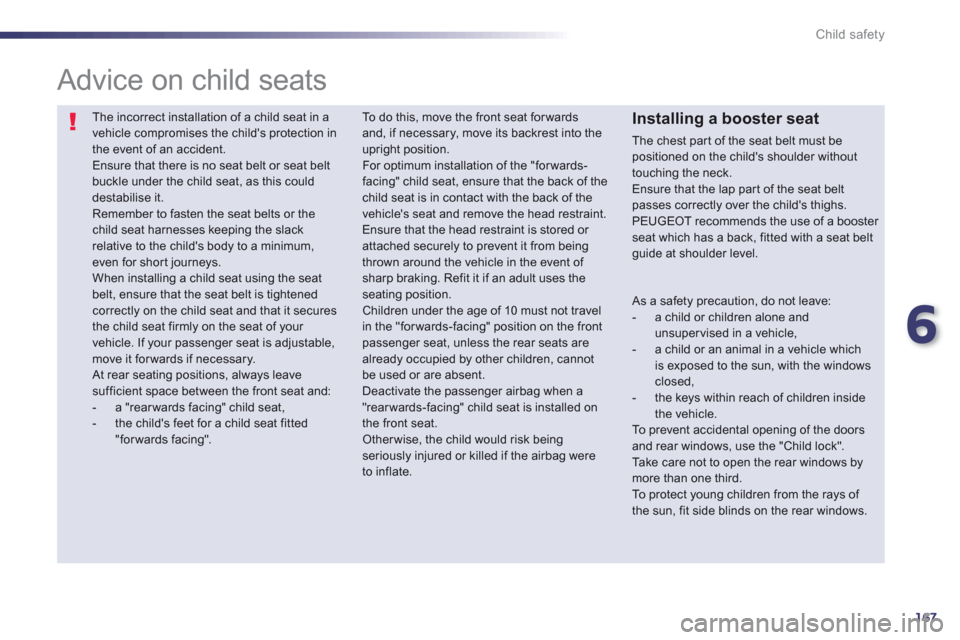
6
167
Child safety
The incorrect installation of a child seat in avehicle compromises the child's protection in the event of an accident.
Ensure that there is no seat belt or seat beltbuckle under the child seat, as this coulddestabilise it.
Remember to fasten the seat belts or the child seat harnesses keeping the slack relative to the child's body to a minimum, even for short journeys. When installing a child seat using the seat belt, ensure that the seat belt is tightenedcorrectly on the child seat and that it secures the child seat firmly on the seat of your vehicle. If your passenger seat is adjustable, move it for wards if necessary. At rear seating positions, always leavesufficient space between the front seat and:
- a "rear wards facing" child seat,
- the child's feet for a child seat fitted"forwards facing".
Advice on child seats
As a safety precaution, do not leave: - a child or children alone and unsuper vised in a vehicle, - a child or an animal in a vehicle whichis exposed to the sun, with the windows closed, - the keys within reach of children inside the vehicle. To prevent accidental opening of the doors and rear windows, use the "Child lock". Take care not to open the rear windows bymore than one third.To protect young children from the rays of the sun, fit side blinds on the rear windows.
To do this, move the front seat forwards and, if necessary, move its backrest into the upright position.
For optimum installation of the "forwards-facing" child seat, ensure that the back of thechild seat is in contact with the back of the vehicle's seat and remove the head restraint.
Ensure that the head restraint is stored or attached securely to prevent it from being thrown around the vehicle in the event of sharp braking. Refit it if an adult uses the seating position. Children under the age of 10 must not travel in the "forwards-facing" position on the front passenger seat, unless the rear seats are already occupied by other children, cannot be used or are absent.
Deactivate the passenger airbag when a "rearwards-facing" child seat is installed on the front seat. Other wise, the child would risk beingseriously injured or killed if the airbag were to inflate.
Installing a booster seat
The chest par t of the seat belt must bepositioned on the child's shoulder without
touching the neck.Ensure that the lap part of the seat beltpasses correctly over the child's thighs.PEUGEOT recommends the use of a booster seat which has a back, fitted with a seat beltguide at shoulder level.
Page 170 of 308
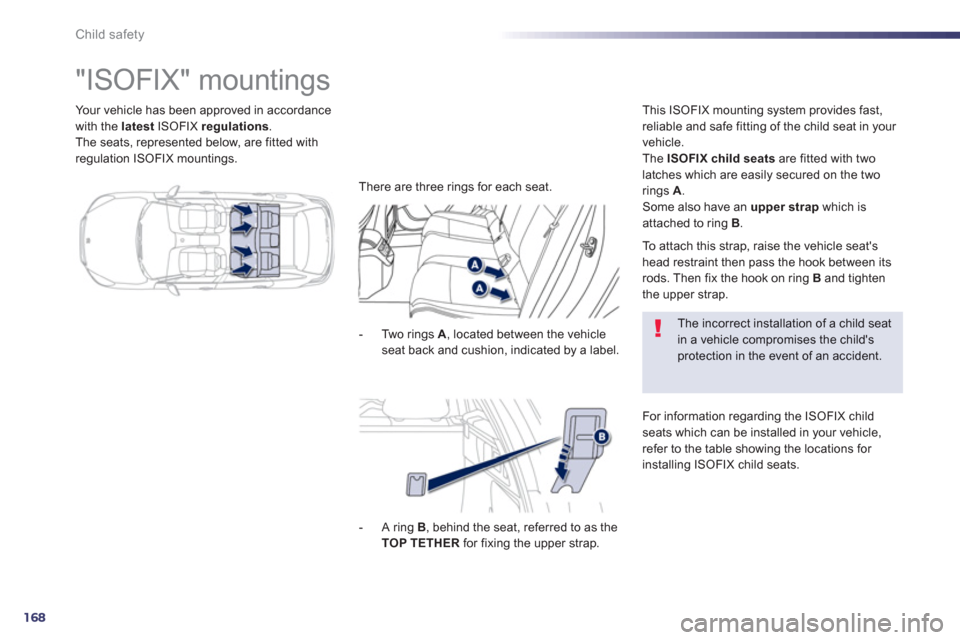
168
Child safety
Your vehicle has been approved in accordance
with the latest ISOFIX regulations .
The seats, represented below, are fitted with
regulation ISOFIX mountings.
"ISOFIX" mountings
- Two rings A
, located between the vehicleseat back and cushion, indicated by a label.
This IS
OFIX mounting system provides fast,
reliable and safe fitting of the child seat in your
vehicle.
The ISOFIX child seatsare fitted with two latches which are easily secured on the two
rings A. Some also have an upper strapwhich isattached to ring B.
The incorrect installation of a child seat in a vehicle compromises the child'sprotection in the event of an accident.
For information re
garding the ISOFIX childseats which can be installed in your vehicle,
refer to the table showing the locations for
installing ISOFIX child seats.
- A rin
g B, behind the seat, referred to as the TOP TETHER
for fixing the upper strap.
To attach this strap, raise the vehicle seat's
head restraint then pass the hook between its
rods. Then fix the hook on ring Band tighten
the upper strap.
There are three rin
gs for each seat.